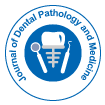Radiographic Diagnosis: Principles, Techniques, and Clinical Applications
Received Date: Apr 01, 2025 / Accepted Date: Apr 30, 2025 / Published Date: Apr 30, 2025
Abstract
Radiographic diagnosis plays a pivotal role in modern clinical practice, especially in dentistry and medical imaging. With advances in technology, radiographic modalities have evolved from conventional film-based radiographs to highly sophisticated digital and three-dimensional imaging systems. This article explores the principles, techniques, interpretation methods, and clinical applications of radiographic diagnosis, highlighting its importance in early disease detection and treatment planning. Radiographic diagnosis remains a cornerstone of modern medical and dental practice, offering a non-invasive, efficient, and highly informative means of visualizing internal structures for diagnostic, therapeutic, and monitoring purposes. The evolution of radiographic technologies over the past century from conventional film-based systems to sophisticated digital imaging modalities has transformed the accuracy, accessibility, and scope of diagnostic imaging. This advancement has not only improved the detection and characterization of pathological conditions but also enhanced the integration of imaging data into clinical decisionmaking and treatment planning. The principles underpinning radiographic diagnosis are rooted in the fundamental interaction between ionizing radiation and biological tissues. Understanding these interactions is essential for optimizing image quality while minimizing patient exposure to radiation. Radiographic imaging techniques, such as intraoral and extraoral projections in dentistry, or chest and skeletal imaging in medicine, depend on precise positioning, exposure control and interpretation skills. Innovations in digital radiography, computed tomography (CT), cone-beam computed tomography (CBCT), and contrast-enhanced imaging have expanded the diagnostic capabilities of clinicians, providing high-resolution, three-dimensional visualizations of anatomical structures with unprecedented detail. Radiographic diagnosis remains a cornerstone in modern clinical practice, providing invaluable insights into the anatomical and pathological conditions of patients. Grounded in the principles of radiation physics and image formation, radiographic techniques have evolved significantly with the advent of digital imaging, computed tomography (CT), magnetic resonance imaging (MRI), and cone-beam computed tomography (CBCT). This advancement has revolutionized diagnostic accuracy across disciplines, including dentistry, orthopedics, oncology, and cardiology. The integration of radiographic modalities into clinical decision-making facilitates early disease detection, treatment planning, and monitoring of therapeutic outcomes. However, it also necessitates a deep understanding of radiation safety, interpretation skills, and diagnostic limitations. This paper explores the foundational principles of radiographic imaging, examines the diverse techniques available, and delves into their clinical applications, while emphasizing best practices and emerging trends that aim to enhance diagnostic efficacy and patient safety.
Citation: Ananya M (2025) Radiographic Diagnosis: Principles, Techniques andClinical Applications. J Dent Pathol Med 9: 269.
Copyright: 穢 2025 Ananya M. This is an open-access article distributed underthe terms of the Creative Commons Attribution License, which permits unrestricteduse, distribution, and reproduction in any medium, provided the original author andsource are credited.
Select your language of interest to view the total content in your interested language
Share This Article
Recommended Journals
91勛圖 Journals
Article Usage
- Total views: 132
- [From(publication date): 0-0 - Sep 04, 2025]
- Breakdown by view type
- HTML page views: 94
- PDF downloads: 38
